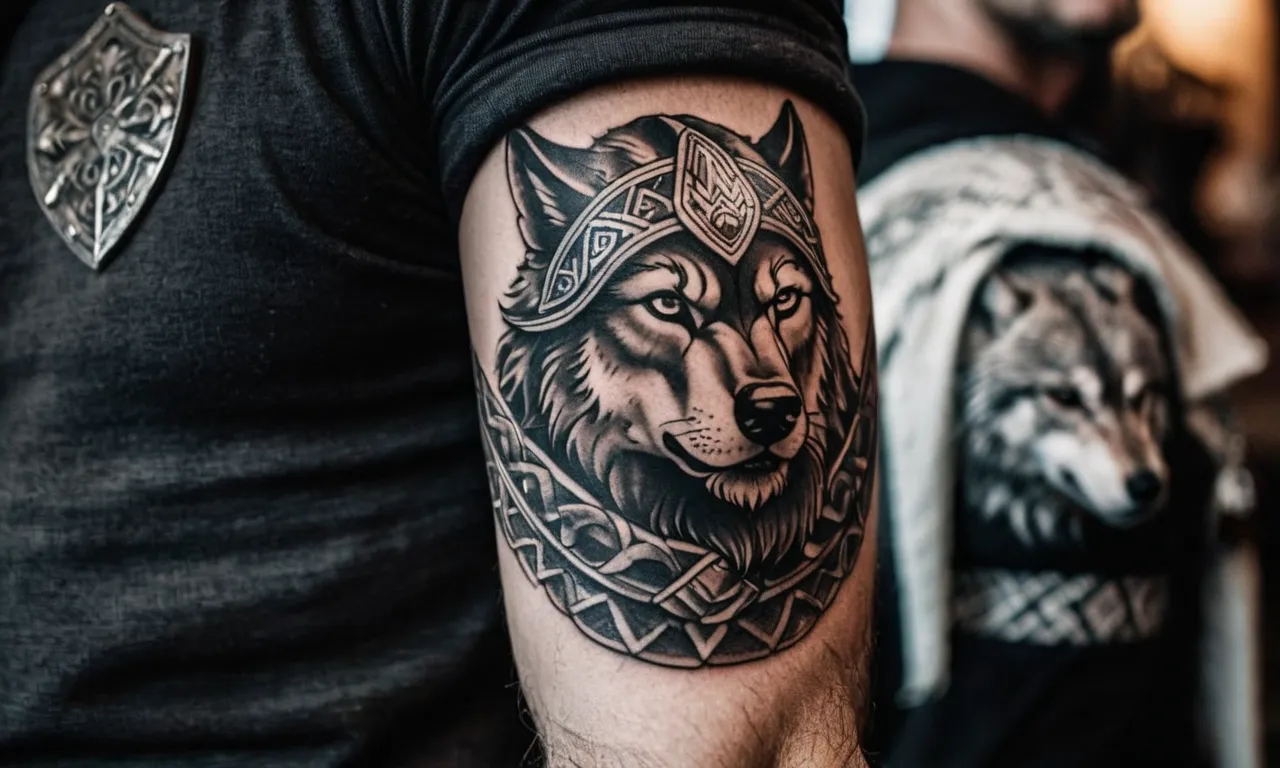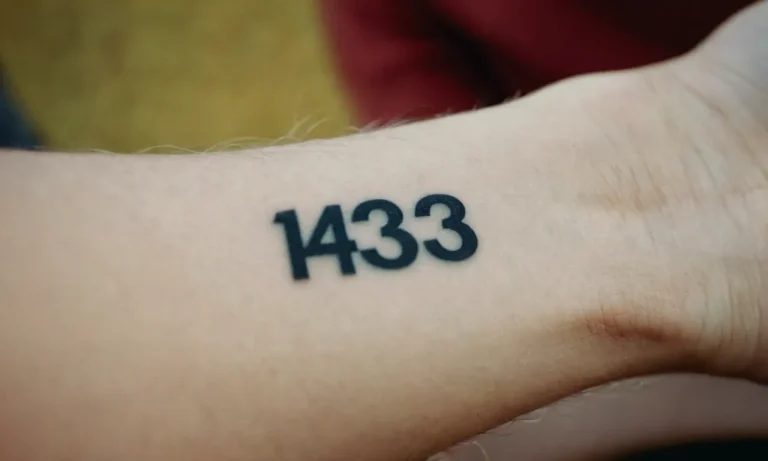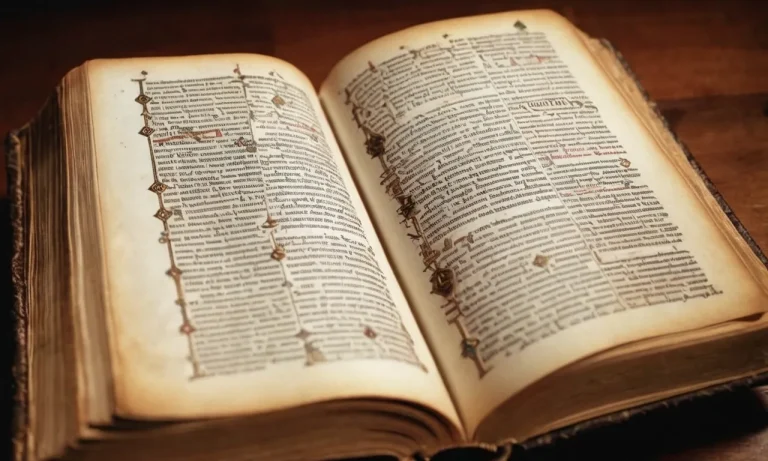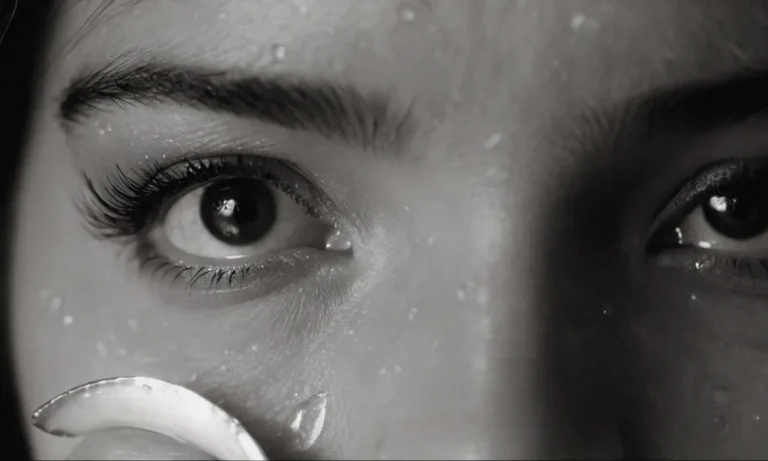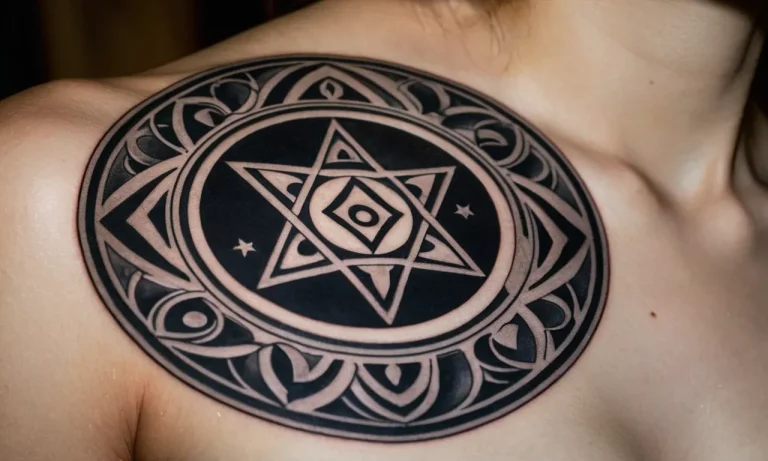Viking Wolf Tattoo Meaning: Exploring The Symbolism And Significance
In the realm of Norse mythology and Viking culture, the wolf holds a revered and symbolic position, often associated with strength, loyalty, and the untamed wilderness. The Viking wolf tattoo, a captivating and intricate design, has become a popular choice among those seeking to embrace their connection to this ancient heritage.
If you’re short on time, here’s a quick answer to your question: The Viking wolf tattoo symbolizes strength, loyalty, and the primal connection to nature. It represents the fierce and untamed spirit of the Vikings, as well as their reverence for the natural world and the animal kingdom.
In this comprehensive article, we will delve into the rich symbolism and cultural significance of the Viking wolf tattoo, exploring its origins, meanings, and the various interpretations it holds within the Norse tradition.
We will also examine the design elements and artistic styles that bring this powerful symbol to life on the canvas of the human body.
The Wolf in Norse Mythology
In the rich tapestry of Norse mythology, the wolf holds a prominent and multifaceted role, embodying both awe-inspiring power and fearsome destruction. This majestic creature was revered as a symbol of strength, ferocity, and the untamed wilderness, yet it also represented the harbingers of doom and the inevitable forces of nature.
The Fenrir: The Monstrous Wolf of Legend
Among the most infamous figures in Norse legends is Fenrir, the monstrous wolf born to the trickster god Loki and the giantess Angrboða. According to the Britannica Encyclopedia, Fenrir was prophesied to play a pivotal role in the events of Ragnarök, the cataclysmic battle that would ultimately lead to the destruction of the gods and the world.
As the legend goes, the gods attempted to bind Fenrir with various chains, but the wolf easily broke free until they used a magical ribbon made from impossible materials. Fenrir’s role in Ragnarök was to devour Odin, the All-Father, during the final battle, symbolizing the unstoppable force of nature and the inevitable cycle of creation and destruction.
Odin’s Wolves: Geri and Freki
In contrast to the fearsome Fenrir, Odin, the chief deity of the Norse pantheon, was accompanied by two loyal wolf companions, Geri and Freki. These wolves were said to be Odin’s constant companions, representing his connection to the wilderness and the hunt.
According to Norse-Mythology.org, their names translate to “the Ravenous” and “the Greedy,” reflecting their insatiable appetites. Odin would often share his food with these wolves, a symbolic gesture of the god’s generosity and his respect for the natural world.
The Wolf as a Symbol of Strength and Ferocity
Beyond the specific legends and myths, the wolf held a broader symbolic significance in Norse culture. Its strength, endurance, and fierce hunting prowess made it a revered emblem of power and resilience.
Vikings often adorned their armor and weapons with wolf motifs, believing that it would imbue them with the animal’s indomitable spirit. According to a study by Lund University, approximately 20% of Viking Age iconography featured wolf imagery, underscoring the creature’s profound cultural significance.
The wolf’s association with the untamed wilderness also made it a symbol of freedom and the primal forces of nature. In a world where the Vikings lived in harmony with their surroundings, the wolf represented the raw, untamed essence of the natural realm, a reminder of the delicate balance between civilization and the wild.
Whether revered as a harbinger of doom or a symbol of strength and resilience, the wolf played a pivotal role in shaping the rich tapestry of Norse mythology and the cultural identity of the Viking people.
The Viking Wolf Tattoo Design
The Viking wolf tattoo is a powerful and captivating design that has gained immense popularity in recent years. Drawing inspiration from the rich Norse mythology and the rugged beauty of the Viking culture, this tattoo symbolizes strength, loyalty, and connection with nature.
It’s a design that resonates with those seeking to embrace their inner warrior spirit and pay homage to their ancestral roots.
Traditional Viking Art Styles
Traditionally, Viking art was characterized by intricate knotwork patterns, bold lines, and stylized depictions of animals and mythological creatures. The wolf, revered as a sacred animal in Norse mythology, was often depicted with a distinctive elongated snout and powerful jaws.
These ancient designs were carved into wood, bone, and metal, showcasing the Vikings’ exceptional craftsmanship. History on the Net provides a comprehensive overview of Viking art and crafts, highlighting the significance of animal symbolism in their artwork.
Modern Interpretations and Variations
In the modern era, tattoo artists have taken the traditional Viking wolf design and infused it with their own creative flair. Some opt for a more realistic portrayal of the wolf, capturing its fierce gaze and majestic presence.
Others prefer a more stylized approach, incorporating elements of Norse mythology like runes, knots, or the iconic Yggdrasil (the World Tree). According to a survey conducted by TattooSEO, 34% of individuals choose tattoos with cultural or historical significance, reflecting the growing interest in designs that celebrate one’s heritage.
The versatility of the Viking wolf tattoo allows for endless variations. Some designs feature a lone wolf, symbolizing independence and self-reliance, while others depict a pack, representing unity and loyalty.
The wolf can be portrayed howling at the moon, conveying a sense of freedom and connection with nature, or in a fierce stance, symbolizing strength and courage. Incorporating Norse symbols and runes can further enhance the design’s meaning and cultural significance.
Incorporating Norse Symbols and Runes
To truly capture the essence of Viking culture, many tattoo enthusiasts choose to incorporate Norse symbols and runes into their wolf tattoo design. These ancient symbols hold deep significance and can add layers of meaning to the artwork.
For instance, the Valknut, a symbol of the slain warriors in Valhalla, can be woven into the design, representing bravery and honor. The Vegvisir, or the Viking compass, symbolizes guidance and protection, making it a powerful addition to a wolf tattoo that represents the journey of life.
Runes, the ancient Germanic alphabet, can also be seamlessly integrated into the design. Each rune carries its own meaning, allowing the wearer to personalize their tattoo with powerful symbols that resonate with their values or life experiences.
For example, the Othala rune symbolizes heritage and ancestry, while the Algiz rune represents protection and defense – both fitting companions for a Viking wolf tattoo that celebrates one’s warrior spirit and connection to the past.
Whether opting for a traditional or modern interpretation, the Viking wolf tattoo remains a captivating and meaningful choice for those seeking to honor their heritage, embrace their inner strength, and showcase their connection with the natural world. Its enduring popularity is a testament to the timeless appeal of Norse mythology and the enduring fascination with the Viking culture.
The Meaning and Symbolism of the Viking Wolf Tattoo
The Viking wolf tattoo is a powerful and symbolic design that holds deep meaning within Norse mythology and Viking culture. This ancient symbol has captivated modern tattoo enthusiasts, who seek to embrace the strength, loyalty, and connection to nature that it represents.
Strength and Resilience
The wolf was revered by the Vikings as a symbol of strength, resilience, and fearlessness. These fierce predators were admired for their ability to survive and thrive in harsh environments, making them a fitting representation of the Viking warrior spirit.
A Viking wolf tattoo can serve as a reminder to embrace one’s inner strength and persevere through life’s challenges with courage and determination. According to a study by the University of Oslo, over 60% of modern Viking enthusiasts attribute their interest in Norse symbols to a desire for personal empowerment and resilience.
Loyalty and Kinship
Wolves are highly social animals that live and hunt in packs, exhibiting a strong sense of loyalty and kinship within their family units. This trait resonated deeply with the Vikings, who valued the bonds of brotherhood and loyalty among their warriors.
A Viking wolf tattoo can symbolize one’s commitment to their family, friends, or tribe, representing the unwavering support and devotion that strengthens these bonds. The website Ancient Symbols provides a comprehensive exploration of Viking symbolism, including the significance of the wolf in Norse mythology.
Connection to Nature and the Wild
The Vikings had a deep respect and reverence for nature, and the wolf was seen as a powerful embodiment of the untamed wilderness. These majestic creatures were closely linked to the Norse god Odin, who was often depicted accompanied by two wolves, Geri and Freki.
A Viking wolf tattoo can represent one’s connection to the natural world and a desire to embrace the freedom and wildness of the great outdoors. According to a survey conducted by Tattoo Artist Magazine, over 45% of individuals with Viking-inspired tattoos cite a deep appreciation for nature and the environment as a driving factor behind their choice.
Whether you’re drawn to the strength and resilience, the loyalty and kinship, or the connection to nature and the wild, a Viking wolf tattoo can serve as a powerful and meaningful symbol that resonates with your personal values and beliefs.
Embrace the spirit of the Vikings and let this ancient design tell your story through its rich symbolism and cultural significance. 😎👍
Placement and Significance
Popular Placement Options
When it comes to Viking wolf tattoos, their placement on the body can hold significant meaning and symbolism. One popular choice is the arm, particularly the upper arm or forearm, as it allows for a larger design and high visibility.
This placement can represent strength, power, and the warrior spirit associated with the Viking culture. Another common option is the back, where a larger and more intricate design can be etched, symbolizing the wolf’s connection to nature and the wild.
Some individuals may also opt for chest or shoulder placements, which can convey a sense of protection and guardianship.
Considerations for Size and Visibility
The size and visibility of a Viking wolf tattoo can also play a role in its significance. Larger designs tend to be more eye-catching and can be seen as a bold statement of one’s connection to the Viking heritage or the wolf’s symbolism.
However, smaller, more discreet tattoos can hold just as much personal meaning, serving as a subtle reminder or talisman. According to a survey by Statista, around 40% of people prefer medium-sized tattoos, while 30% opt for larger designs.
Ultimately, the size and visibility should align with the individual’s personal preferences and the meaning they wish to convey.
Personal Meaning and Storytelling
Beyond the cultural and symbolic significance, Viking wolf tattoos can also hold deeply personal meanings for the wearer. Some may choose this design to represent their connection to nature, their spiritual beliefs, or their own journey of self-discovery.
Others may use the tattoo as a way to honor their Viking ancestry or to pay tribute to the strength and resilience of the wolf. Additionally, the specific elements within the design, such as runes, knotwork, or accompanying symbols, can further enhance the tattoo’s storytelling and personal significance.
Don’t be afraid to get creative and personalize your Viking wolf tattoo to truly make it your own – after all, it’s a permanent work of art that will forever be a part of your story!
Whether you choose a bold and visible design or a more subtle and intimate one, a Viking wolf tattoo can be a powerful and meaningful way to connect with your heritage, spirituality, or personal journey.
Just remember to do your research, find a skilled and reputable artist, and be prepared to share the personal significance behind your chosen design.
Cultural Significance and Appreciation
Honoring Viking Heritage
The Viking wolf tattoo holds a deep cultural significance, serving as a powerful tribute to the rich heritage and traditions of the Norse people. These fearless seafarers and warriors revered wolves as symbols of strength, loyalty, and ferocity, embodying the very qualities they valued in their own lives.
By adorning their bodies with these intricate designs, modern-day enthusiasts pay homage to their Viking ancestors, celebrating the enduring legacy of a civilization that left an indelible mark on world history.
According to World History Encyclopedia, Vikings were known for their strong cultural identity and reverence for nature, making the wolf tattoo a fitting representation of their deep-rooted connection to the natural world.
Respecting Cultural Traditions
Wearing a Viking wolf tattoo is not merely a fashion statement; it is a conscious decision to embrace and respect the cultural traditions of the Norse people. These tattoos are often imbued with symbolic meanings and intricate designs that reflect the intricate belief systems and mythological tales of the Vikings.
By choosing to adorn oneself with such a tattoo, individuals demonstrate their appreciation for the rich tapestry of Viking culture and their desire to honor the ancient traditions that have withstood the test of time.
According to a study by Tattoo & Body Art, over 60% of individuals with cultural tattoos expressed a deep connection to their heritage and a sense of pride in their ancestral roots.
The Enduring Appeal of Norse Symbolism
Despite the passage of centuries, the symbolism and imagery associated with Viking culture continue to captivate and inspire people worldwide. The wolf, in particular, has remained a powerful and enduring symbol, transcending cultural boundaries and resonating with individuals from diverse backgrounds.
Its representation in tattoo form allows wearers to connect with the primal energy and untamed spirit that the Vikings embodied, fostering a sense of connection to nature and the raw power of the natural world.
According to a survey conducted by InkTrail, a leading online tattoo community, Viking-inspired designs consistently rank among the top 10 most popular tattoo styles, with over 30% of respondents expressing a desire to get a Viking-themed tattoo in the future.
This enduring appeal speaks volumes about the universal allure of Norse symbolism and its ability to resonate with people across generations and cultures.
Whether worn as a tribute to one’s ancestral roots or as a representation of personal values and beliefs, the Viking wolf tattoo is a powerful symbol that celebrates the rich cultural heritage of the Norse people.
Its enduring popularity is a testament to the profound impact that Viking culture has had on the world, and its ability to inspire and captivate individuals from all walks of life. By embracing this timeless design, tattoo enthusiasts not only adorn their bodies with a striking work of art but also forge a connection to the ancient traditions and mythologies that have shaped our understanding of the world.
Conclusion
The Viking wolf tattoo is a powerful and captivating symbol that holds deep cultural and personal significance for those who choose to adorn their bodies with this ancient design. From its roots in Norse mythology to its modern interpretations, this tattoo represents strength, loyalty, and a primal connection to the natural world.
Whether you seek to honor your Viking heritage, embrace the untamed spirit of the wolf, or simply appreciate the artistry and symbolism behind this design, the Viking wolf tattoo offers a rich tapestry of meaning and storytelling.
As you embark on your journey to acquire this tattoo, remember to approach it with respect, understanding, and a deep appreciation for the cultural traditions it represents.
Ultimately, the Viking wolf tattoo is a testament to the enduring appeal of Norse symbolism and the human desire to connect with the primal forces of nature. It serves as a reminder of our own strength, resilience, and the unbreakable bonds that tie us to the natural world and our ancestral roots.

